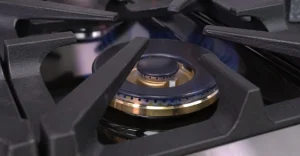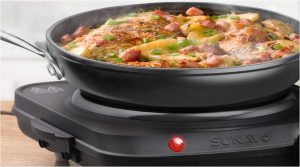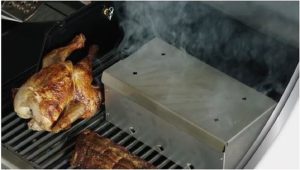Solved! Hot Plate Turn Off Frequently and Other Common Issues
Your hot plate turns off frequently due to built-in safety features or potential malfunctions.
Most modern hot plates come with safety features to prevent overheating and potential hazards. One common feature is an automatic shut-off mechanism, which activates if the device detects an abnormally high temperature. This is designed to ensure user safety and prolong the appliance’s lifespan.
In some instances, a hot plate might cycle on and off to maintain a specific temperature or protect its internal components.
If you’ve ever wondered what happens if you leave a hot plate on, it can lead to overheating and potential fire risks. Continuous operation can strain the device and result in damage over time. This is one reason many hot plates have built-in timers or auto-off functions, providing peace of mind and reducing the chances of accidents.
But, it’s not always safety mechanisms at play. If your hot plate keeps turning off unexpectedly, it could hint at an underlying issue. It may be due to faulty wiring, a malfunctioning thermostat, or wear and tear from frequent use.
Read More: Top 4 Best Hot Plates with Auto Shut-off
Basics of Hot Plate Operation
Hot plates have become a staple in many kitchens, hostels, labs, and workshops due to their compact design and functionality. At their core, they function by converting electrical energy into heat, which is then transferred to the cooking vessel placed on top.
Two primary types dominate the market: electric coil and induction. Electric coil hot plates use an exposed heating coil, which heats the cookware through direct contact. Induction hot plates, on the other hand, employ electromagnetic fields to induce a current in the cookware, generating heat directly within it. Therefore, the choice of cookware matters, especially for induction models.
Both types come with thermostats to regulate temperature. The mechanism involves a sensor detecting the plate’s temperature and adjusting the power supply to maintain the desired heat level.
As the temperature approaches the set point, the device might reduce power, leading to a drop in heat, and then increase it again when needed. This cycle ensures even cooking and prevents overheating.
Read More: Top 8 Hot Plates For Candle Making And The Process
Why Your Hot Plate Turn Off? Reasons & Solutions
Hot plates are essential kitchen appliances, but like all electrical devices, they can present issues. Knowing the reasons behind these problems can help in troubleshooting and ensuring the prolonged usage of the device.
1. Safety Mechanisms
Most hot plates have built-in safety features to prevent overheating or potential fire hazards.
- Automatic Shut-off: Hot plates might turn off automatically after reaching a certain temperature or if left on for an extended period. This is to ensure the device doesn’t overheat.
- Tilt Sensors: Some hot plates turn off if they detect an imbalance or if they’re tilted to prevent spills or accidents.
2. Electrical Issues
Faults in the electrical system can cause a hot plate to malfunction.
- Short Circuits: A compromised wire or faulty connection can interrupt the power supply, causing the hot plate to turn off.
- Power Surges: Sudden spikes in your home’s electricity can force the hot plate to shut down as a protective measure.
3. Wear and Tear
Continuous usage can lead to the natural degradation of the hot plate.
- Lifespan: All electrical appliances have a lifespan, and once they reach this point, issues like turning off spontaneously can occur.
- Physical Damage: Cracks, fractures, or other visible damages can affect the hot plate’s functionality.
4. User Errors
Sometimes, the issues might arise from the way the appliance is used.
- Incorrect Settings: Setting the temperature too high or choosing the wrong mode can cause the hot plate to turn off.
- Lack of Maintenance: Not cleaning the hot plate regularly or exposing it to moisture can result in malfunctions.
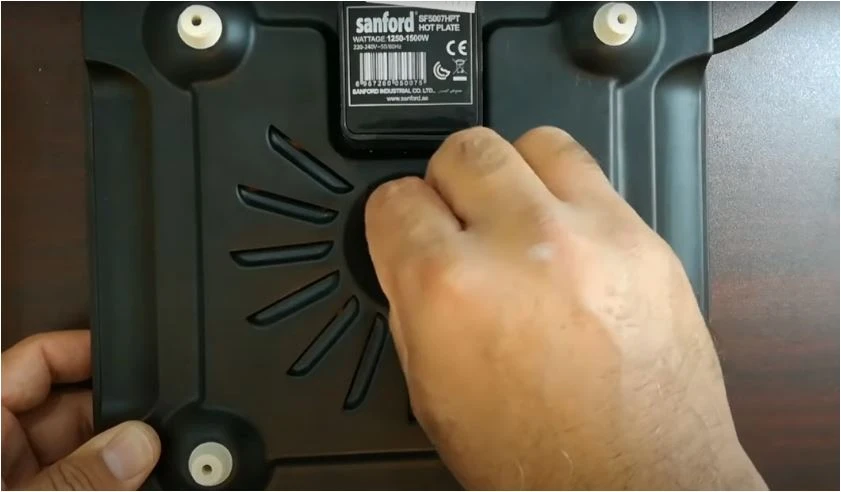
Preventive Actions
Noticing your hot plate intermittently shutting off and powering back on might be perplexing, but it’s often a built-in safety feature. Many hot plates are equipped with automatic shut-off mechanisms to prevent potential hazards.
If the appliance detects temperatures exceeding safe limits, it temporarily powers down to cool off, subsequently powering back on to continue cooking. It’s essentially the appliance’s way of self-regulating to prevent overheating or potential damage.
For those seeking a seamless cooking experience without these interruptions, taking preventive actions is key. Firstly, ensure that the cookware used is appropriate for the hot plate type. For induction plates, magnetic-based cookware is essential.
Another preventive measure is to regularly inspect the appliance for any debris or residual food particles that might be obstructing its surface or vents. Keeping the appliance clean ensures better heat conductivity and reduces the chances of overheating.
Moreover, users should refrain from operating their hot plates at maximum temperatures for extended periods. Opt for medium to high settings and adjust accordingly as the food cooks. This method not only conserves energy but also puts less strain on the device, ensuring a longer, more efficient operation.
Learn More: Can You Put a Beaker on a Hot Plate: Facts and Precautions
Common Hot Plate Problems, Their Causes, and Solutions
Hot plates are versatile appliances, but like any device, they can present challenges. Familiarizing oneself with common hot plate issues, their root causes, and potential fixes can ensure a smoother, safer cooking experience.
Inconsistent Heating
Causes
Worn-Out Heating Element: Just like other appliances, the heating element of a hot plate can wear out over time due to repeated usage. A malfunctioning element might not distribute heat evenly, leading to uneven cooking or heating.
Faulty Thermostat: The thermostat controls the temperature. If it’s faulty, the plate may not reach the desired temperature or may overheat.
Solutions
Replace the Heating Element: If the element is visibly damaged or not working efficiently, consider replacing it. Many brands offer replacement parts.
Check and Replace the Thermostat: If you suspect the thermostat is the issue, consult the user manual or contact the manufacturer for guidance on checking and replacing it.
Hot Plate Doesn’t Turn On
Causes
Faulty Power Cord: Power cords can get damaged over time, leading to a break in the flow of electricity.
Blown Fuse: Some hot plates have internal fuses that can blow if there’s an electrical surge or if the device is overloaded.
Solutions
Inspect and Replace Power Cord: Check for any visible damage to the power cord. If found, replace the cord with a compatible one.
Replace the Fuse: Refer to the user manual for guidance on locating and replacing the fuse. Ensure the replacement fuse has the same specifications.
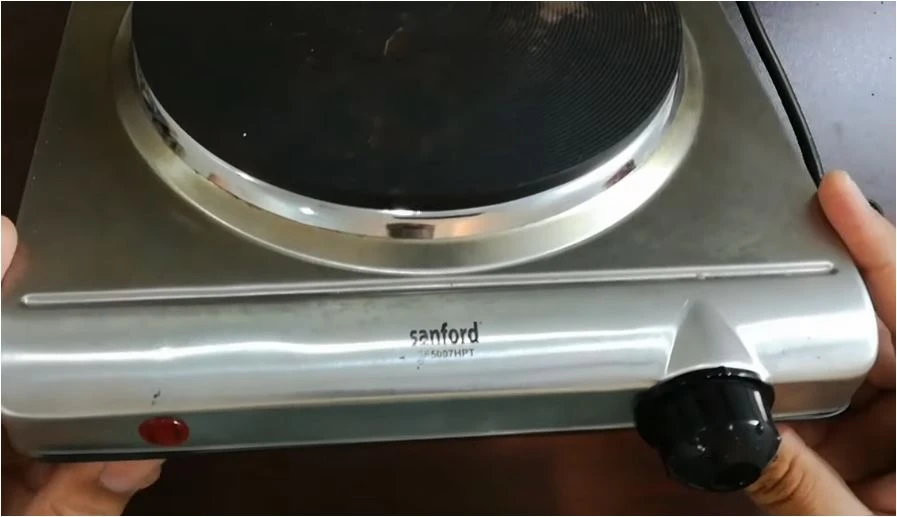
Overheating Even at Low Settings
Causes
Malfunctioning Temperature Control: The temperature control knob or switch might not be working properly, causing the plate to overheat even at low settings.
Internal Component Issues: There could be internal electrical or component problems causing the hot plate to overheat.
Solutions
Inspect Temperature Control: Ensure that the knob or switch is properly attached and functioning. If not, it might need replacement.
Professional Inspection: If you can’t identify the cause, it might be best to get the hot plate inspected by a professional or contact the manufacturer for support.
Hot Plate Produces Sparks
Causes
Wiring Issues: Loose or frayed wires can lead to sparking.
Foreign Objects: Small metallic objects or food particles can sometimes fall into the plate and cause sparks.
Solutions
Check Wiring: Turn off the device and unplug it. Open the casing, if possible, and inspect for any loose or damaged wires. Secure or replace them as needed.
Clean the Plate: Ensure the plate is free from any debris or foreign objects. Clean it regularly to avoid the buildup that can cause sparking.
Light Indicator Malfunctions
Causes
If the indicator light doesn’t turn on or keeps flickering, it might be due to a faulty bulb or internal wiring issues.
Solution
Replace the indicator bulb. If the problem persists, the wiring might be the issue, and professional intervention may be required.
Making Noises or Vibrations
Cause
Odd noises or vibrations can be attributed to a misaligned coil or an internal component coming loose.
Solution
Ensure the coil is properly seated and aligned. If the issue continues, refrain from using the hot plate and seek professional assistance.
Featured Image Credit: Amazon.com
